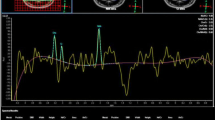Abstract
Our aim was to determine and/or predict response to treatment of brain tumors in children using proton magnetic resonance spectroscopic imaging (MRSI). We studied 24 patients aged 10 months to 24 years, using MRI and point-resolved spectroscopy (PRESS; TR 2000 TE 65 ms) with volume preselection and phase-encoding in two dimensions on a 1.5 T imager. Multiple logistic regression was used to establish independent predictors of active tumor growth. Biologically vital cell metabolites, such as N-acetyl aspartate and choline-containing compounds (Cho), were significantly different between tumor and control tissues (P < 0.001). The eight brain tumors which responded to radiation or chemotherapy, exhibited lower Cho (P = 0.05), higher total creatine (tCr) (P = 0.02) and lower lactate and lipid (L) (P = 0.04) than16 tumors which were not treated (except by surgery) or did not respond to treatment. The only significant independent predictor of active tumor growth was tCr (P < 0.01). We suggest that tCr is useful in assessing response of brain tumors to treatment.
Similar content being viewed by others
Author information
Authors and Affiliations
Additional information
Received: 26 July 1999 Accepted: 27 July 2000
Rights and permissions
About this article
Cite this article
Tzika, A., Zurakowski, D., Poussaint, T. et al. Proton magnetic spectroscopic imaging of the child's brain: the response of tumors to treatment. Neuroradiology 43, 169–177 (2001). https://doi.org/10.1007/s002340000454
Issue Date:
DOI: https://doi.org/10.1007/s002340000454




